Get the Most Out of Art Critique
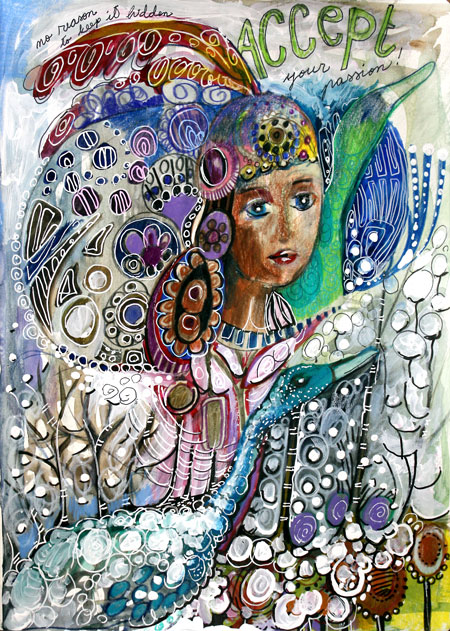
My latest art journal page is inspired by a discussion in an art journal group. It was about how to deal with the criticism towards your art. One woman told a story which touched me deeply. Someone had accidentally seen photos of her art and asked if they were made by her little grandchildren. After that she did not feel comfortable making art again. The story made me think about how important other people’s reactions to our arts and crafts is. How much we yearn for comments and how the critique can scare us. I also share those feelings. These are my conclusions of the subject. (And yes, I have new pencils!)
1) Pick Your Specialists
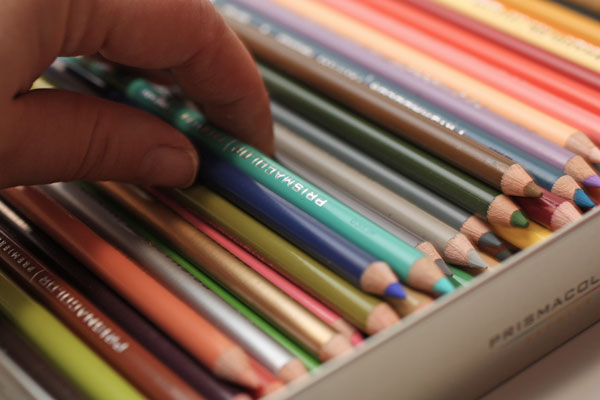
“Can you simplify, Paivi?”, said my teachers in so many words while I was studying industrial design. Because, in design, it all starts from the basic concepts, basic shapes and little alterations to them. I have always loved decorating. So I rushed through the first design decisions to get into adding swirls and tiny dots to the each of the designs. When I completed a sketch for a bar code reader, a teacher said: “What can I say, it is like a Russian icon painting with a flair of folk”. And he did not even know I had painted icons as a child!
“Your sketches all look the same”, he continued.
I did not get it. For me, they were all so different.
– “The same shape is repeated all over again.”
When I went back home, I thought that studying industrial design was going to change me to the direction I did not like. Within a year I would be living on a white box with no carpets on the floor and wear black glasses. But the end result was nothing like. My interest in art history and decorative art only increased within the time as practicing different styles helped me realize there’s no need to create a too narrow image of my own art.
At the end of the studies, one of the teachers said to me, carelessly: We just got an application from a person who reminded you: so many details, so little simplifying! We can’t accept him in. To design is to simplify. Despite your beginning, you do have learned that.” It meant a world to me – according to her, I was a simplifier, a designer.
In today’s world, there’s a specialist for everything. I yearned for the specialist to testify, objectively. And once she did, I was happy. But later I have begun to think that actually, in art, everyone has to define their own specialists. The range of art and design is huge and surely, everybody doesn’t like every piece of art.
So, don’t even expect that everybody likes your art – is a specialist of your style. Pick those that you want to please and forget the rest!
2) Improve Your Communication
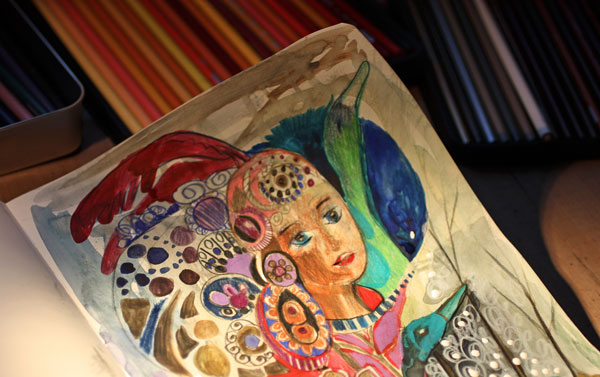
An artist Ann Rea has said: “Art is communication”. I think that focusing on what we want to say with our art is often more beneficial than focusing on the techniques. When someone comments our art, whether the feedback is positive or negative, we can always ask: “What do you see here? How does it make you feel? What do you like the most?” (Or “like the least”, if you are brave enough, and if you have chosen the person to be your specialist.)
Sometimes it is not so much about delivering a certain message, but touching people. When we are touched by our own art, it may seem surprising that others do not get touched by it. Then we need to improve our visual communication or fill in the story verbally. (The power of art journaling!)
Instead of thinking “I want to become a better artist” you may want to think “I want to become a better visual communicator.” After that, you will often find art critique easier to swallow!
3) Set the Risk Level
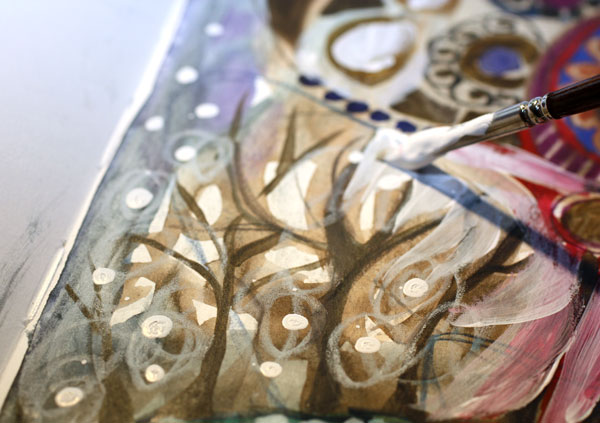
If you only want to hear positive comments, set the risk level low. One way to do that is to stick with the realistic art and copy those who have a lot of general acceptance.
But if you want to find your own style and in the end, truly touch people, take more risks! Experiment, observe, let go of the definitions you use for yourself, think about before you start to create and while creating, stop thinking! You can set the risk level for each individual piece, and go higher from one artwork after another.
Once in a while, give yourself a permission to make high-risk art! Sometimes it may also be good to take high risks when asking for comments! But never let anyone keep you away from creating when you are on the way of unique self-expression.
In need of experimenting? – Join me for an art journaling workshop!
This is one of the many art journal pages inspired by embroidery techniques. Meet me at 21 Secrets Art Journaling Workshop where I will show you my favorite embroidered textiles and teach you how to imitate the embroideries with pens and paper! The perfect project if you want to stretch your style in a safe environment! The workshop begins in April, but you can preorder now!
10 thoughts on “Get the Most Out of Art Critique”
Comments are closed.
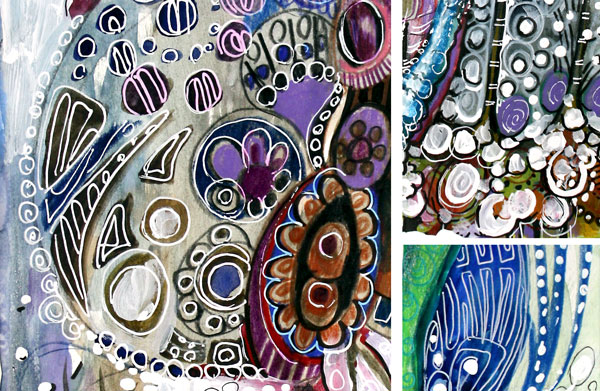
Thank you for this insightful post!
I recently discovered your website and blog. I am simply in love with your work! Whenever I need a burst of color in my day (it’s winter now in the USA), I look at some of your gorgeous work. It makes me happy. I’ve started to do more doodling myself–nothing comparable to yours 🙂 but still lots of fun and quite addictive. Have a very happy New Year. I’m looking forward to following your artwork in the coming year.
Thank you, Sherry! Here in Finland it is like in winter wonderland, I could not resist adding some snow in the page too! Great to hear that you are doodling, have fun!
Beautiful art, Paivi! I am a hobby artist who came to it about 10 years ago as a therapy for and escape from my arthritis pain and to de-stress. Along with that was the fact that I could not become commercial, and in that frame of mind I’ve long noticed that most others do leave that commercial possibility open and or are actively pursuing it. So few of them will give honest critiques for fear of not being PC (what they say may hurt them down road). And most of us just do not want to hurt others’ feelings. So, it is really silly to ask publicly for criticism. If you want it, choose others you admire and ask them in private email. I find that most who DO ask publicly are really asking for validation. Sometimes it comes off as pretty pitiful, too, as well as the “lemming effect” of the gushing replies. Lots of artists are woefully insecure. Could we all just DO our art and remember that all art is subjective? Just my two cents….xoxo
Aimeslee, thanks for your thought-provoking comment! It made me think: What makes critique public and what is asking critique publicly? Perhaps the word “critique” here can be interpreted in many ways. My first versions of the title were “How to Get the Most Out of People’s Comments … or “… of People Commenting Your Art” but they were too long for the search engine so I replaced the term “comments” with the term “Critique”.
Thus, we may be talking about slightly different things. I feel that I get “critique”, or “feedback”, or “comments” where ever I post or show my art. I suppose most of us do. I find it interesting and valuable.
Your brilliant comment made me think why. It probably comes from my background in user centric design and product development where customer feedback is seen valuable. To refer back to the contents of the blog post, I have chosen the readers of this blog to be “my specialists” in some respect.
I think that you need to choose your specialists according to the goals of your art. The most centric goal in my art is that it has to provoke people create their own art.
So, readers, when you look at my art, I hope you:
1) feel inspired to start creating yourself.
2) are captivated with the image so that you take a moment from your busy life and think about how does it reflect to you (which in turn makes creating easier as you will have your own content to use)
3) feel uplifted by the beauty that originates from the history of art and design (I am not the artist to go to if you want to see the pain and agony, not that I value those artists, it’s just not me)
Then there’s the question of quality – the quality of techniqal skills, composition, use of color, originality, playfulness etc. But I feel that even if you break art to pieces (there are very comprehensive art theory books about that), the most important question is: what do you want to accomplish with your art and does your piece succeed in that?
My goal is not to be another great artist in world history but to be a reminder of everything that can be found there!
Now, I challenge all of you determining your goals in art! (Now I feel I have to blog about this subject this spring to cover it more widely!)
Aimeslee, thanks so much!
I absolutely love every one of your posts. Since I’ve started following you I’ve made a practice of doing more intuitive art and the difference is amazing to me! I plan on taking the spring workshop just because I’m very interested in your portion. Thanks!!!
Shannon, thanks so much!! Welcome to the workshop! If you read my response to the previous comment, you can understand how happy you made me by saying that you have began to do more intuitive art! Have a creative, wonderful new year!
Greetings from sunny Australia. Your website and blog have given me much joy and inspiration through 2014. I love the description Russian icons with a folk flare….exactly the style I am drawn to. Now with all the New Year enthusiasm of stop procrastinating and DO that is just what I plan….a lot more DO of the things I love…Russian icons and folk flare! Many Happy Days to you and yours.
Dawn, thanks!! Go for it!!
When I have been in your art journal -courses, I decided to use mixed media and art journal -style in my last portfolio in Käsityön taiteen opinnot. I was very excited to try something new – I have studied six years as a hobby. I had lot to do in my portfolio, but I was quite pleased.
But what was the result: teachers didn’t like my portfolio. They said that the appearance was scrappy. I had thought that it is important to find your own voice. How can you find it if you don’t try different things?
After all, it was very proud that I have courage to try. My portfolio makes me feel happy:-)
Merja, I am certain that your portfolio is something you will cherish for a long time! The style of the art journal might have been too artsy for the teachers who must have aimed for the graphic look. (One way to make an art journal look more graphic is to scan the pages, add text with the computer, then print the pages again.) However, self-expression is always valuable! You should be proud!